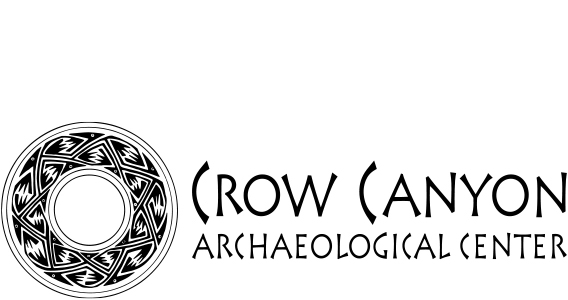When we asked our friend and partner, Nate Francis, to design a new logo to honor Crow Canyon’s 40th anniversary and welcome the decades to come, he approached it very thoughtfully. “It took a while to figure out how I was going to do this project,” explained Nate.
Nate’s family originates from the Tewa-speaking Pueblo people of New Mexico and Arizona, he grew up in the Four Corners region, and presently lives in Albuquerque, New Mexico. Nate is passionate about teaching Ancestral Pueblo history and the history of his Tewa ancestors as a guide and through his involvement with Crow Canyon. “I appreciate the path Crow Canyon has created in teaching the public about the ancestral world by allowing Indigenous people to tell our stories,” he shared.
In designing the logo, it was important to Nate to weave in elements from his ancestral past and present-day experiences. He explains the ideas behind his illustrations.
“I came up with the perspective of looking inside a pottery bowl which is broken into four sections, each representing a pottery sherd, because in the Indigenous perspective everything is in fours, 4 directions, 4 worlds, 4 seasons, 4 phases of life and more. Then, when you take the imagery out, the four panels and logo in the middle represent “4” and “0” for 40 years.”
Upper left: “This sherd represents agriculture. The top image is of rainclouds because Indigenous tribes believe without water there is no life. The next image is of the corn maiden, the corn mother and life giver to Pueblo and Hopi Tribes. In the ancestral world, agriculture was the reason for building permanent homes and to settle from being nomadic.”
Upper right: “This sherd represents human movement. The big circle could represent the ‘middle place’ and migration where Pueblo and Hopi were in the search of before finding their place in this world. The petroglyphs depict a panel in Bears Ears National Monument, where I served as a Tewa/Hopi scholar during a Crow Canyon trip.”
Bottom left: “This sherd represents the Chaco culture. The left image is of a t-shaped door that is a sacred symbol to Pueblo and Hopi culture that was highly used in ancestral Puebloan times. The next image is of the Bears Ears National Monument, an area that holds a special meaning to various Southwestern tribes.”
Lower right: “This sherd represents human existence. The lower image shows the summer solstice as Father Sun comes up behind Ute Mountain (Yucca Mountain in Tewa), starting to warm the land. This can be seen from Bears Ears as you look to the east. The stars represent human observance of celestial surroundings.”
Learn about Nate and his art at unekfrancis.com and @unek\francis on Instagram.



